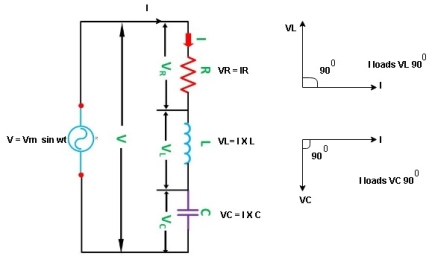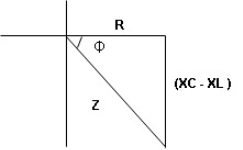Q1)Explain single phase AC supply ?
A1)In the field of electrical, single phase supply is the delivery of AC power by a system in which all the supply voltages change in simultaneously. This type of power supply sharing is used when the loads (home appliances) ate generally heat and lighting with some huge electric motors. When a single phase supply is connected to an AC motor doesn’t generate a rotating magnetic field, single phase motors require extra circuits for working, but such electric motors are rare over in rating of 10 kW. In every cycle, a single phase system voltage achieves a peak-value two times; the direct power is not stable.
Single Phase Waveform A load with single-phase can be power-driven from a three-phase sharing transformer in two techniques. One is with the connection between two phases or with connection among one phase and neutral. These two will give dissimilar voltages from a given power supply. This type of phase supply provides up to 230V. The applications of this supply mainly use for running the small home appliances like air conditioners, fans, heater, etc. Single Phase Supply Benefits The benefits of choosing a single phase supply include the following.
Single Phase Supply Applications The applications of single-phase supply include the following.
Q2) Explain pure resistive circuit?
A2)Ac circuit containing pure resisting
Consider Circuit Consisting pure resistance connected across the ac voltage source V = Vm Sin ωt ① According to ohm’s law i = But Im =
Phases diagram From ① and ② Power P = V. i Equation P = Vm sin ω t Im sin ω t P = Vm Im Sin2 ω t P =
Constant fluctuating power if we integrate it becomes zero
Average power Pavg = Pavg = Pavg = Vrms Irms
Power ware form [Resultant]
Q3) Explain pure inductive circuit?
Ac circuit containing pure Inductors
Consider pure Inductor (L) is connected across alternating voltage. Source V = Vm Sin ωt When an alternating current flow through inductance it setups alternating magnetic flux around the inductor. This changing the flux links the coil and self-induced emf is produced According to faradays Law of E M I e = at all instant applied voltage V is equal and opposite to self-induced emf [ Lenz's law] V = -e
But V = Vm Sin ωt
Taking integrating on both sides
but sin (–
And Im=
= -ve = lagging = I lag v by 900
Waveform:
Phasor:
Power P = Ѵ. I = Vm sin wt Im sin (wt = Vm Im Sin wt Sin (wt –
And Sin (wt - Sin (wt –
The average value of sin curve over a complete cycle is always zero
Q4) Explain pure capacitive circuit?
Ac circuit containing pure capacitors:
Consider pure capacitor C is connected across an alternating voltage source Ѵ = Ѵm Sin wt Current is passing through capacitor the instantaneous charge ɡ produced on the plate of the capacitor ɡ = C Ѵ ɡ = c Vm sin wt the current is the rate of flow of charge
i = c Vm w cos wt then rearranging the above eqth. i =
i = but
= leading = I leads V by 900 Waveform :
Phase
Power P= Ѵ. i = [Vm sinwt] [ Im sin (wt + X/2)] = Vm Im Sin wt Sin (wt + X/2)]
Q5) Explain series R-L-C circuits?
Consider ac voltage source V = Vm sin wt connected across the combination of R L and C. when I flowing in the circuit voltage drops across each component as shown below. VR = IR, VL = I
① XL> XC, ② XC> XL, ③ XL = XC ① XL > XC: Since we have assumed XL> XC
VL and VC are 180 0 out of phase. Therefore cancel out each other
Now V = VR + VL + VC From voltage triangle V =
Impendence
Rectangular form Z = R + j (XL – XC) Polor form Z = Where And Ø = tan-1
i = i = as VL
Now V = VR + VL + VC From voltage V = V =
Polar form : Z = Where And Ø = tan-1 –
as VC since i =
ɡȴ XL= XC then VL= VC and they are 1800 out of phase with each other Hence resultant V = VR and it will be in phase with I as shown in the below phasor diagram.
From the above resultant phasor diagram V =VR + IR Or V = I Because lZl + R Thus Impedance Z is purely resistive for XL = XC and circuit current will be in phase with source voltage.
ie pang = Vrms I rms cos Ø = 1 cos o = 1 maximum power will be transferred by the condition. XL = XC
Q6) Explain three phase supply ?
The three phase system consist four wires, three conductors and one neutral. The conductors are out of phase and space 120º apart from each other. The three phase system is also used as a single phase system. For the low load, one phase and neutral can be taken from the three phase supply.
Q7) Explain the star and delta connections?
The three phase supply is continuous and never completely drops to zero. In three phase system power can be drawn either in a star or delta configuration. The star connection is used for long distance transmission because it has neutral for the fault current.
The delta connection consists three phase wires and no neutral.
Q8) Explain line and phase values?
The three- phase supply is continuous and never completely drops to zero. In three phase system power can be drawn either in a star or delta configuration. The star connection is used for long distance transmission because it has neutral for the fault current. The delta connection consists three phase wires and no neutral. Line and Phase Values: • The three components comprising a three-phase source or load are called phases. • Line voltage is the voltage measured between any two lines in a three-phase circuit. • Phase voltage is the voltage measured across a single component in a three-phase source or load. • Line current is the current through any one line between a three-phase source and load. • Phase current is the current through any one component comprising a three-phase source or load. • In balanced “Y” circuits, the line voltage is equal to phase voltage times the square root of 3, while the line current is equal to phase current. For Y circuits E line = I line = I phase • In balanced Δ circuits, the line voltage is equal to phase voltage, while the line current is equal to phase current times the square root of 3. For Δ circuits Eline = Ephase I line = • Δ-connected three-phase voltage sources give greater reliability in the event of winding failure than Y-connected sources. However, Y-connected sources can deliver the same amount of power with less line current than Δ-connected sources.
Q9) Explain the solution of balanced three phase circuits?
The following steps are given below to solve the balanced three-phase circuits. Step 1 – First of all draw the circuit diagram. Step 2 – Determine XLP = XL/phase = 2πfL. Step 3 – Determine XCP = XC/phase = 1/2πfC. Step 4 – Determine XP = X/ phase = XL – XC Step 5 – Determine ZP = Z/phase = √R2P + X2P Step 6 – Determine cosϕ = RP/ZP; the power factor is lagging when XLP > XCP and it is leading when XCP > XLP. Step 7 – Determine the V phase. For star connection VP = VL/√3 and for delta connection VP = VL Step 8 – Determine IP = VP/ZP. Step 9 – Now, determine the line current IL. For star connection IL = IP and for delta connection IL = √3 IP Step 10 – Determine the Active, Reactive and Apparent power.
Q10) Explain the phasor diagram?
Phasor Diagram :
Equation VR = Vm Sin wt VY = Vm Sin (wt-1200) VB = sin (wt – 2400) Or VB = Vm sin (wt + 1200)
Q11) Explain the advantages of single phase over three phase?
ɡȴ same amount of power is to transmitted than the cross-sectional area of conductor used for 3 Ø system is small as compared to that for single Ø system.
Q12) Explain the applications of three phase supply?
|



















































































































































